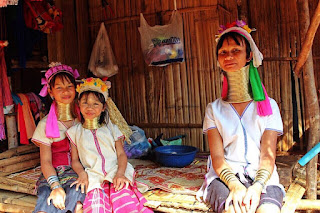Hill Tribes (Thailand)
The Karen is the largest of the hill tribes’ group in Thailand. Originated from Tibet the Long neck tribe, otherwise known as the ‘giraffe women’ are famous for the long brass coils they wear around their necks. They are animists with a strong belief in the spirit world. Karen traditionally wears tunics and sarongs, handwoven by the females of the family. They also like to wear turbans of wrapped cloth on their heads. The costumes vary slightly between the sub-groups, but the difference between a married woman’s dress and an unmarried woman’s dress is significant. An un-married woman’s costume is a long dress with white tunic down to her ankles. A married woman wears sarong and a brightly colored style shirt with elaborate patterns and seeds sewn on them. They are the only tribe in Thailand to own and work with elephants. They are famous as highly skilled mahouts. The Karen grow rice, corn, soybeans, cabbage, and coffee. Traditionally they live in bamboo stilt houses with their domestic animals such as chickens and pigs living underneath.
The Akha are highly superstitious holding strong beliefs about the spirit world. Most notably, their villages are known for their unusual spirit gates which separate the border between the spirit world and physical world. These gates are sacred and should not be touched by humans at any cost. The Akha believe that this will disturb the spirits and bring bad luck upon the whole village. The Akha people generally live in bamboo houses and are separated by gender. One side is for the women and the other side occupied by men. They are expert farmers and skilled hunters. Women wear broad leggings, short black skirt, black jacket with heavily embroidered cuffs and lapels and are known for their embroidery skills. The headdresses worn by the women are perhaps the most spectacular and elaborate items of Akha dress. Akha women define their age or marital status with the style of headdress worn. During mid-adolescence women start wearing the adult woman's headdress.
The Hmong are the second largest hill tribe group in Thailand and originated from China. They are mostly known for their production of hemp and batik techniques. The Hmong are the most commercially astute and business savvy and the wealthiest of the groups. Traditionally their villages can be instantly recognized by their ground level wooden houses (unlike the raised stilt bamboo houses of other tribes). The Blue Hmong females wear pleated skirts made of hemp dyed with blue and white batik patterns. The male’s clothes are also made of loose-fitting black material, with colorful embroidery on the jackets. In addition to colorful costumes, the Hmong wear silver for adornment and as a display of wealth. They also believe in spirits and souls, so in each village there’s a shaman to exorcise evil spirits away.
The Lahu are known as ‘Musers’ a Burmese word meaning ‘hunters’ because they are renowned for their superior hunting skills. The most common group in Thailand are the Black Lahu who make up 80% of the Lahu population. They are mainly located in Chiang Rai and Chiang Mai. Lahu women wear black and red jackets whilst men wear baggy green or blue pants. Although they are primarily subsistence farmers (rice and corn), they are proud of their hunter gatherer heritage. They remain strict, serious people governed by firm principles of right and wrong, Every individual answers to the elders’ collective will. The Lahu are strongly committed to unity for survival, and may have the most gender-equitable society in the world.
The Lisu are found in Myanmar, India, and Thailand. They believe all animate things have an associated spirit. Most live close to water because they believe water has extraordinary power. Lisu men dress consists of a black jacket, blue or green pants, and black leggings. Silver buttons (many) are sewn on the shirt. They also wear a red sash around their waist with a shoulder bag. Lisu women’s dress is a blue or green tunic, split up at the sides to the waist. It goes down to the knee in front and hangs to mid-calf at the back. It crosses over the chest and fastens under the right arm. The piece across the chest is often a different color from the rest of the dress. They also wear knee-length black Chinese-style pants and red leggings trimmed with blue cloth. Young girls wear black turban during festivals and on New Year Day, they wear lots of silver jewelry.
The Yao are primarily Buddhists but have traditional animistic beliefs, which assumes no separation between the spiritual and physical world. They prefer high altitude dwellings with their homes usually on solid ground. In a traditional home, you will find a communal living area, few bedrooms, and a guest area. Typically, they grow corn and rice as their primary crops. Women wear long black jackets with scarlet woolen lapels. They also wear loose black pants embroidered with exquisite designs and a matching black turban. Besides that, the Yao beautifully dress up their children. The babies commonly wear intricately embroidered caps. Men wear loose jackets with embroidered pockets and trim. The silversmiths are renowned throughout Thailand for their impressive skills.
Map of the Hill Tribe's Location
Famous Cards









This was really a great read! Love the differentiation between all groups; along with their spiritual beliefs & practices.
ReplyDelete